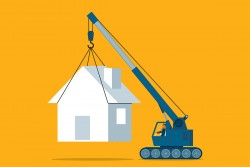The government's target of building 300,000 homes every year is putting pressure on the construction industry to rethink building methods. The National House Building Council estimates that around 10% of new homes built in 2015 used modern methods of construction (MMC), so would this be an option to expand on for the future?
The industry needs to speed up the delivery of new homes while not compromising on quality. We also have to achieve this while facing a demographic crisis and a shortage of labour.
MMC has recently been defined by a government working group. Can you talk us through how the term will now be understood and why this is important?
It has puzzled me that so much emphasis has been placed by the government on encouraging "offsite construction", "offsite manufacturing" and "modern methods of construction" without providing a widely accepted definition of what these terms mean.
The planning committee of the London Assembly produced some definitions in its 2017 report. It defined "offsite manufacture" (OSM) as housebuilding that relies on individual components being manufactured in a factory and assembled on-site. "Offsite construction" allows for most construction phases to be undertaken simultaneously – site preparation, foundations and utilities are prepared on site while the structural components are being assembled in a factory.
While helpful, those definitions are still vague. Recognising the lack of centralised information, the Ministry of Housing, Communities and Local Government established an MMC working group, which is focusing on three areas: MMC terminology and definitions; quality assurance and warranty; and evidence-building and routes to data collection.
The group introduced seven categories of MMC. Category one considers 3D pre-manufactured systems – complete room or storey modules built in a factory and lowered onto foundations on-site.
Meanwhile, category seven considers site process-led improvements. This could be anything including the use of techniques such as tunnel-form in-situ concrete, site process robotics and drones, or autonomous plant and equipment and drones.
In between those two categories is the full spectrum of innovation. The intention is not to be prescriptive about what MMC should look like, but to recognise a wide range of innovations that are being introduced to build more homes with fewer people.
However, any new method of building homes will only be acceptable if it is trusted. The report therefore recognises the need for a quality assurance scheme for MMC technologies, building the trust required for mortgage lending and building insurance.
Most importantly, how long can the structure be expected to last? This is a question of the longevity of not just the individual components but the combination that makes up the whole dwelling.
The Construction Industry Training Board (CITB) estimates that 195,000 more workers will be required to meet the government's targets. Could MMC overcome this shortage?
The change in working practices and the structure of the industry would be revolutionary. Housebuilding is dominated by SMEs, with the on-site workforce consisting of tradespeople operating as individual contractors or SMEs.
To characterise such labour as a resource that can simply be moved into factories and assume that this move will be welcomed is a gross simplification.
Increasing the level of participation in skilled trades is a long-term challenge. Greater recognition and support of trades through the education system would be a welcome solution.
Plastering is plastering, tiling is tiling. Whether you do that on site or in a factory, the time required to complete the individual task is likely to be the same.
However, most manufacturers that supply the housebuilding industry have focused their R&D on solutions that reduce the time – and in many cases the skill – required to use their products, from roofing manufacturers moving to dry-fix components, the plumbing industry moving to push-fit systems or our own aircrete blocks introducing Thin-Joint.
I think great progress is being made at all levels to speed up many of the trades involved in delivering houses and the benefits can be delivered on site as well as in a factory.
How can MMC help construction projects keep to deadline?
The really big timesaver for MMC is likely to occur when foundations and ground works can happen at the same time as structural components are manufactured. This does not have to involve the use of entire modular units, which are less likely to be appropriate for infill sites or short lead times, but can use prefabricated 'panelised' components for walls, floors and roofs.
Do you think the quality of housing – particularly affordable and social housing – will improve with modular construction?
Building in a factory does not necessarily produce better or more measurable quality than building on site does. You get better quality through good design, adequate skills and training, and proper oversight.
Will more funding for associations and councils increase the adoption of MMC?
Radical innovation needs investment in both manufacturing and training. Social housing, with long-term committed funding, could provide the certainty that would allow innovation to flourish.









